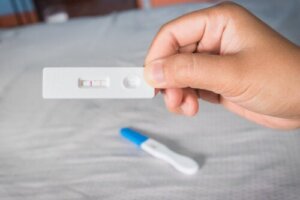Why Do False Negative and False Positive Pregnancy Tests Occur?


Written and verified by the doctor Mariel Mendoza
Have you heard about false negatives and false positives in pregnancy testing? Do you know what each of these refers to? Well, the starting point is that failures are possible when it comes to these tests. Even though they currently have a remarkable degree of sensitivity and specificity, sometimes they don’t give an accurate result.
To understand this better, we must remember that these tests detect a hormone known as ‘human chorionic gonadotropin (hCG)’. This hormone is secreted through the placenta from the beginning of pregnancy and can be detected in both the urine and blood. Its levels increase as a pregnancy progresses.
However, there are some situations in which the test is defective or has errors in its results. Thus, it’s possible to get a positive result without actually being pregnant (false positive), or a negative result despite being pregnant (false negative). We’ll tell you more about this in this article.
What is human chorionic gonadotropin?
Pregnancy test failures occur because of erroneous readings of human chorionic gonadotropin hormone levels. Often, the ‘beta’ subunit of this hormone is measured, which is why the pregnancy test is called a ‘beta-hCG’ test.
Normally, levels of this hormone increase progressively as pregnancy progresses, especially in the first trimester. They double every 48 to 72 hours, reaching a peak at around 12 weeks gestation.
hCG itself is a chemical produced largely by placental syncytiotrophoblast cells during pregnancy. Its function is to stimulate the corpus luteum to produce the progesterone needed to maintain pregnancy.
It can be detected in both blood and urine. However, blood tests are considered more sensitive because they detect lower levels of the hormone and allow for both qualitative and quantitative measurements.
- Qualitative measurement identifies whether it’s present or absent.
- Quantitative measurement detects levels.
Meanwhile, urine pregnancy tests can be done at home and require higher levels of the hormone for detection. In addition, they depend on how the user uses them. Therefore, if there are errors in its performance, it’s also more likely to fail.
It’s important to mention that the hormone is detected between 14 and 17 days after conception. Therefore, it’s recommended to wait for 15 days after unprotected sex or at least one day after delayed menstruation for a more accurate result.
We think you may be interested in reading this, too: Pregnancy Triggers Brain Changes to Promote Bonding with Children, Studies Show

A false negative pregnancy test, one of the most common forms of failure
False negatives are the most common pregnancy test failures. They can be caused by different situations, such as the following:
- Very early stages of gestation. It’s recommended to wait for one to three days after the delay of menstruation or at least 15 days after sexual intercourse without contraceptive protection.
- Very diluted urine. This can result in very low concentrations of human chorionic gonadotropin hormone. Therefore, it’s recommended to use it during the first urination of the morning.
- Incorrect use of the pregnancy test, such as an error in the place of urine placement or time exposure. It’s essential to follow the indications to the letter.
Now, if the result is negative, but there are still doubts or menstruation doesn’t appear, the test should be repeated after five or six days (or at least two days apart) to corroborate the result.
Failing that, you can also perform a blood pregnancy test or consult your doctor (who may suggest a transvaginal ultrasound).
False positives in pregnancy tesst
When the pregnancy test is positive, there is a greater than 97% chance that it’s true. However, sometimes there are failures and false positives can occur. This usually occurs when there are situations where the human chorionic gonadotropin hormone is elevated without pregnancy. For example:
- Some germ cell cancers (gonadotropin-secreting tumors).
- Trophoblastic disease (choriocarcinoma).
- Hormonal treatment for assisted reproduction processes (sometimes human chorionic gonadotropin hormone is used as part of the therapy).
- Taking certain medications, such as some anticonvulsants, diuretics, or anxiolytics. For this reason, you should read the package insert of the drugs and inform your doctor about their use.
It may also occur in other cases of non-viable pregnancies such as the following:
- An ectopic pregnancy, which occurs outside the uterus, and the chances of favorable development are low.
- Anembryonic or anembryonic pregnancy (without embryo).
- After a miscarriage.
After a miscarriage, there is a progressive decrease in human chorionic gonadotropin hormone. Therefore, it can take weeks before it’s undetectable. This is why the test yields positive results in the absence of pregnancy.
However, it’s necessary to follow up, because if the levels don’t decrease after several days, it may indicate that embryonic remains are still in the uterine cavity. If so, the physician should intervene.
Ultimately, when the home pregnancy test is read outside of the recommended time frame, it can yield false positives. The same is true if the test is overdue.

Like this article? You may also like to read: The Mucous Plug in Pregnant Women: What Is It and What’s Its Function?
Pregnancy test failures can be avoided with proper use
The most important thing to avoid pregnancy test failures is to use the test properly and use the most sensitive test possible. On the other hand, it should not be performed before the indicated date. This is especially true for women undergoing assisted reproduction treatments, as false positives can occur.
That said, it’s essential to perform the test when indicated by the physician. In addition, it’s advisable to follow all the indications step by step. Most of the time, failures are due to the use of expired tests or poor performance.
In summary, some recommendations are as follows:
- Repeat the test three to five days later.
- Don’t read the test results until after the time indicated in the test instructions has passed.
- Consult a gynecologist after 4 to 5 weeks.
- Prefer blood pregnancy tests with quantitative quantification.
A blood pregnancy test will be requested whenever a false negative is suspected. In addition, a transvaginal ultrasound will be performed in search of the gestational sac and embryo.
All cited sources were thoroughly reviewed by our team to ensure their quality, reliability, currency, and validity. The bibliography of this article was considered reliable and of academic or scientific accuracy.
- Betz D, Fane K. Human Chorionic Gonadotropin. [Updated 2022 Aug 8]. In: StatPearls [Internet]. Treasure Island (FL): StatPearls Publishing; 2023 Jan-. Available from: https://www.ncbi.nlm.nih.gov/books/NBK532950/
- Braunstein GD. False-positive serum human chorionic gonadotropin results: causes, characteristics, and recognition. Am J Obstet Gynecol. 2002 Jul;187(1):217-24. doi: 10.1067/mob.2002.124284. PMID: 12114913.
- DeLaney M, Wood L. Urine pregnancy testing: When does no mean maybe? J Am Coll Emerg Physicians Open. 2021 Sep 28;2(5):e12567. doi: 10.1002/emp2.12567. PMID: 34611652; PMCID: PMC8479369.
- Herskovits AZ, Chen Y, Latifi N, Ta RM, Kriegel G. False-Negative Urine Human Chorionic Gonadotropin Testing in the Clinical Laboratory. Lab Med. 2020 Jan 2;51(1):86-93. doi: 10.1093/labmed/lmz039. PMID: 31245816.
- McCash SI, Goldfrank DJ, Pessin MS, Ramanathan LV. Reducing False-Positive Pregnancy Test Results in Patients With Cancer. Obstet Gynecol. 2017 Oct;130(4):825-829. doi: 10.1097/AOG.0000000000002244. PMID: 28885416; PMCID: PMC5724973.
- Montagma M, Trenti T, Aloe R, Cervellin G, Lippi G. (2011). Human chorionic gonadotropin in pregnancy diagnostics. Clínica Chimica Acta 412, 17-18. https://www.sciencedirect.com/science/article/abs/pii/S0009898111003007?via%3Dihub
- Ogino MH, Tadi P. Physiology, Chorionic Gonadotropin. [Updated 2022 Nov 7]. In: StatPearls [Internet]. Treasure Island (FL): StatPearls Publishing; 2023 Jan-. Available from: https://www.ncbi.nlm.nih.gov/books/NBK556118/
- Raymond E, Anger H, Chong E, Haskell S, Grant M, Boraas C, et al. “False positive” urine pregnancy test results after successful medication abortion. Oregon Health & Science University. https://pubmed.ncbi.nlm.nih.gov/33596414/
- Theofanakis C, Drakakis P, Besharat A, Loutradis D. (2017). Human Chorionic Gonadotropin: The Pregnancy Hormone and More. Int J Mol Sci, 18, 5. https://www.ncbi.nlm.nih.gov/pmc/articles/PMC5454971/
This text is provided for informational purposes only and does not replace consultation with a professional. If in doubt, consult your specialist.








